前言
最近要做课设大作业,是一个有两层权限的共享图书管理系统,在之前已经完成了需求分析和概要设计后,现在要开始正式编码了
由于有先前学生信息管理系统的工程经验,这次很多细节的东西就带过了


详细设计
数据结构

依然是通过Navicat图形化数据库软件来创建数据对象,分别为三种使用者以及书籍,其内部要素如下
BOOK
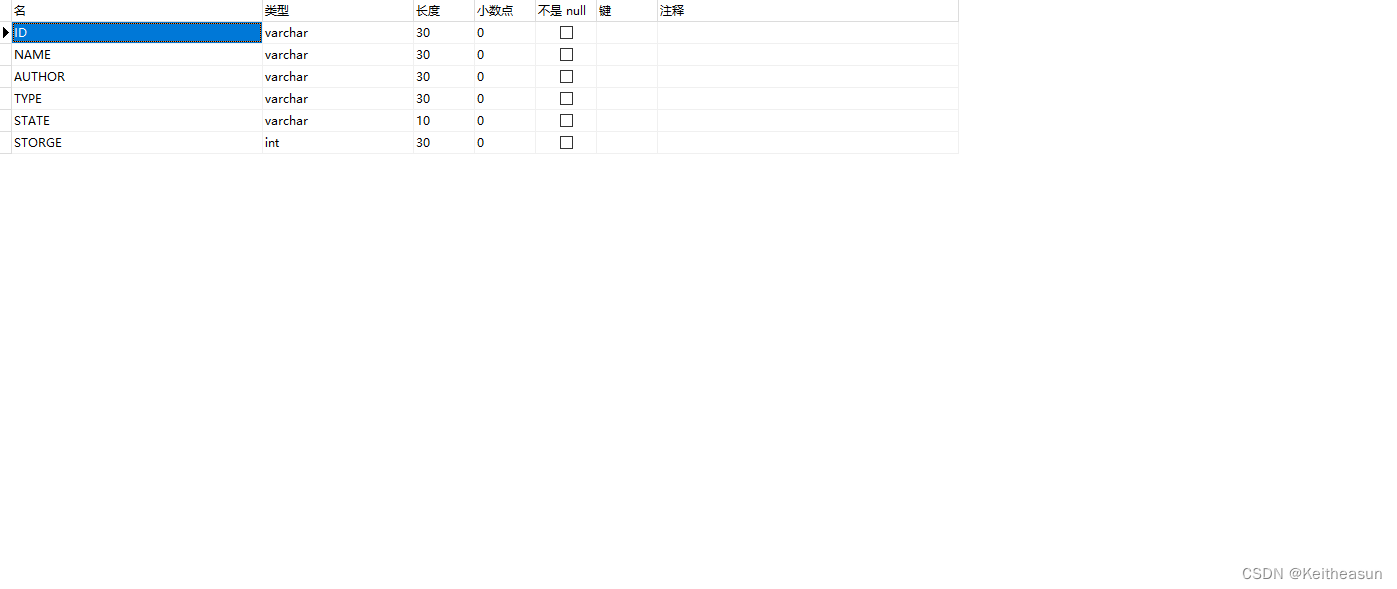
CLIENT

MANAGER
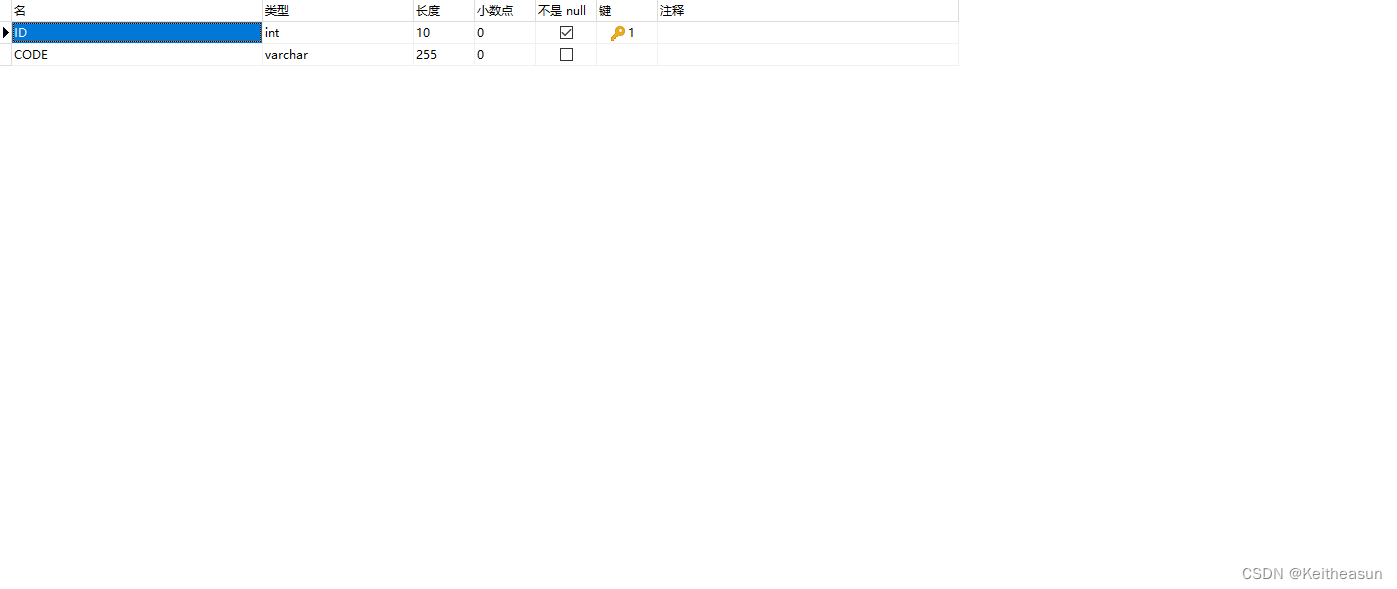
ROOT_MANAGER

这些信息可以和思维导图中的对象属性对应上,编码期间我做了一些修改,不过大致是相同的
框架搭建
UI设计我用的是Python自带的GUI库Tkinter

使用者调用程序后最先会进入主菜单,主菜单分别有三个功能提供给三种使用者

使用者可根据自己的定位来使用系统中的功能
角色分析
该系统我打算分成三个使用者,分别为:用户,管理员以及超级管理员,他们的权限是一层层递进的,其中,用户和超级管理员均继承管理员的部分权限
管理员功能
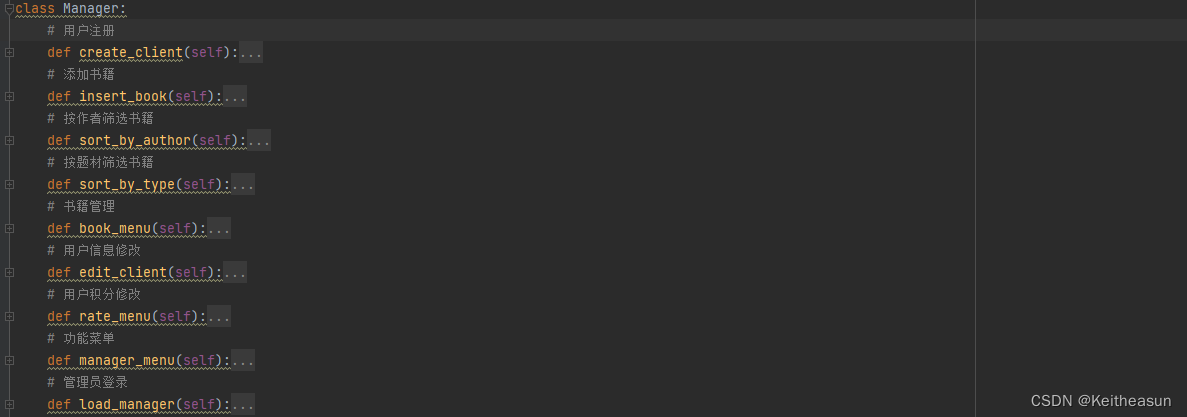
管理员可以对用户和书籍进行管理,其登录界面如下
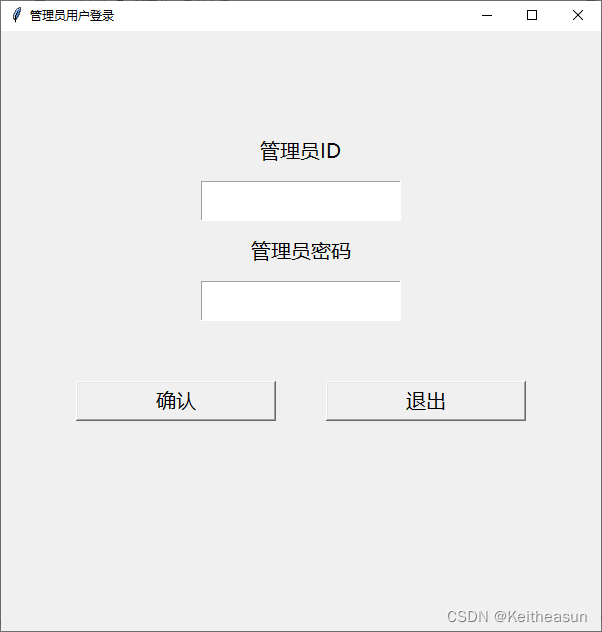
功能菜单
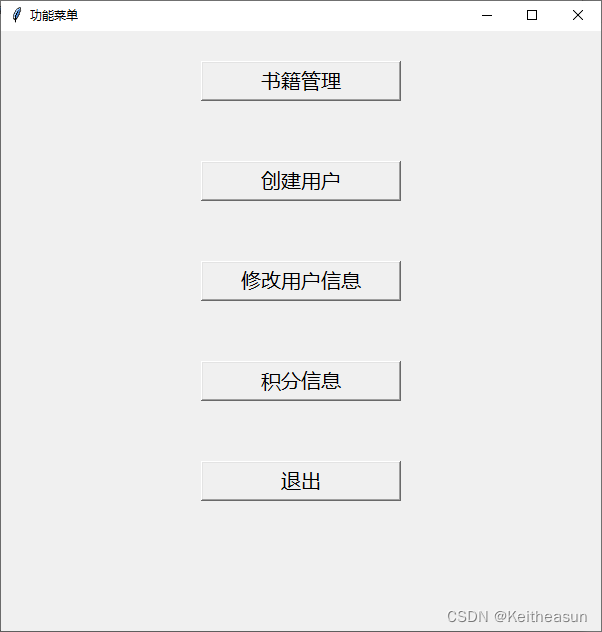
超级管理员功能
 超级管理员拥有管理员的所有权限,同时可以管理管理员的信息,超级管理员只有一个,不可增删,其功能界面如下
超级管理员拥有管理员的所有权限,同时可以管理管理员的信息,超级管理员只有一个,不可增删,其功能界面如下
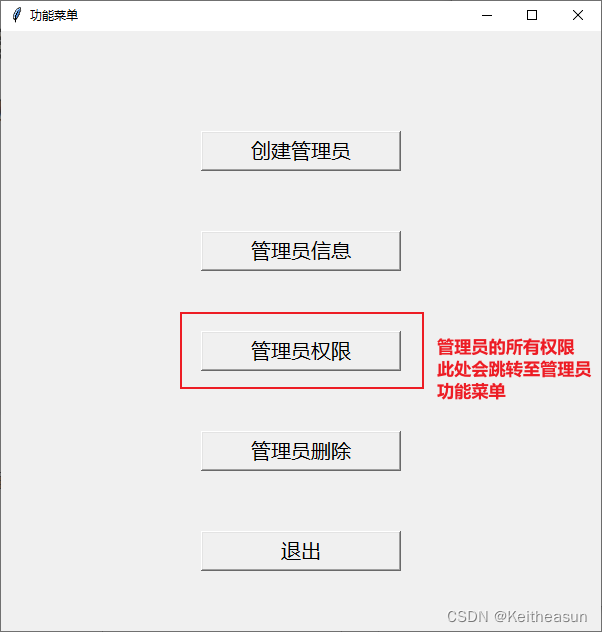
用户功能

用户继承了管理员对书籍管理的权限,可以借出或赠予,执行不同的操作后用户积分会发生改变,当积分为0时用户无法借书,系统在用户登录时会显示用户积分数,用户登录页面如下

用户菜单如下
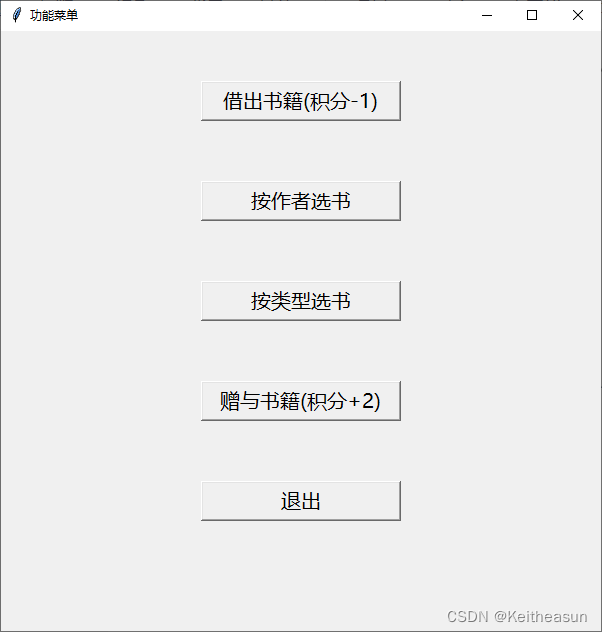
算法实现
总结分析后可以将该系统中要实现的功能分为以下几类:录入信息、匹配信息、修改信息、展示信息,接下来我会用系统中的部分例子来介绍这些功能如何实现
录入信息
以添加书籍为例
# 添加书籍
def insert_book(self):
# 创建窗口
insert_book_root = Tk()
insert_book_root.title("添加书籍")
insert_book_root.config(width=600)
insert_book_root.config(height=800)
# 定义关联变量
book_id = StringVar(insert_book_root, value='')
book_name = StringVar(insert_book_root, value='')
book_author = StringVar(insert_book_root, value='')
book_type = StringVar(insert_book_root, value='')
book_state = StringVar(insert_book_root, value='')
book_storge = StringVar(insert_book_root, value='')
# 提示性标签
labelbook_id = Label(insert_book_root, text="书籍id", font=("微软雅黑 -20"))
labelbook_name = Label(insert_book_root, text="书籍名称", font=("微软雅黑 -20"))
labelbook_author = Label(insert_book_root, text="书籍作者", font=("微软雅黑 -20"))
labelbook_type = Label(insert_book_root, text="书籍种类", font=("微软雅黑 -20"))
labelbook_state = Label(insert_book_root, text="书籍状态", font=("微软雅黑 -20"))
labelbook_storge = Label(insert_book_root, text="书籍库存", font=("微软雅黑 -20"))
# 设定标签位置
labelbook_id.place(x=200, y=30, height=40, width=200)
labelbook_name.place(x=200, y=130, height=40, width=200)
labelbook_author.place(x=200, y=230, height=40, width=200)
labelbook_type.place(x=200, y=330, height=40, width=200)
labelbook_state.place(x=200, y=430, height=40, width=200)
labelbook_storge.place(x=200, y=530, height=40, width=200)
# 定义录入信息文本框,以关联变量形式存储
entrybook_id = Entry((insert_book_root), textvariable=book_id)
entrybook_id.place(x=200, y=80, height=40, width=200)
entrybook_name = Entry((insert_book_root), textvariable=book_name)
entrybook_name.place(x=200, y=180, height=40, width=200)
entrybook_author = Entry((insert_book_root), textvariable=book_author)
entrybook_author.place(x=200, y=280, height=40, width=200)
entrybook_type = Entry((insert_book_root), textvariable=book_type)
entrybook_type.place(x=200, y=380, height=40, width=200)
entrybook_state = Entry((insert_book_root), textvariable=book_state)
entrybook_state.place(x=200, y=480, height=40, width=200)
entrybook_storge = Entry((insert_book_root), textvariable=book_storge)
entrybook_storge.place(x=200, y=580, height=40, width=200)
# 录入信息回调函数
def Button_Ok():
# 设置标志位判断是否存在ID重复
flag = 0
# 连接数据库
db, cur = Sql_link()
# 将得到的StringVar对象传值回来
data_book_id = str(entrybook_id.get())
data_book_name = str(entrybook_name.get())
data_book_author = str(entrybook_author.get())
data_book_type = str(entrybook_type.get())
data_book_state = str(entrybook_state.get())
data_book_storge = str(entrybook_storge.get())
# 判断是否信息重复
search1 = cur.execute("SELECT * FROM book WHERE name = '%s'" % data_book_name)
search2 = cur.execute("SELECT * FROM book WHERE author = '%s'" % data_book_author)
if (search1 > 0 and search2 > 0):
flag = 1
else:
flag = 0
if (flag == 0):
try:
# 写入数据
sql1 = "INSERT INTO book(id,name,author,type,state,storge)"
sql1 += "VALUES('%s','%s','%s','%s','%s','%s')" % (
data_book_id, data_book_name, data_book_author, data_book_type, data_book_state, data_book_storge)
cur.execute(sql1)
db.commit()
messagebox.showinfo(title="恭喜", message="录入成功!!!")
insert_book_root.destroy()
except:
messagebox.showerror(message="注册失败!!!")
else:
# 查找对应的ID号
sql2 = "UPDATE book SET storge = storge + %d WHERE name = '%s'" % (
eval(data_book_storge), data_book_name)
cur.execute(sql2)
db.commit()
messagebox.showinfo(title="恭喜", message="录入成功!!!")
# 确认以及退出按钮
Ok_Button = Button(insert_book_root, text="确认", font=("微软雅黑 -20"), command=Button_Ok)
Exit_Button = Button(insert_book_root, text="退出", font=("微软雅黑 -20"), command=insert_book_root.destroy)
Ok_Button.place(x=75, y=650, height=40, width=200)
Exit_Button.place(x=325, y=650, height=40, width=200)
结合代码来看,首先通过Tk中的接收数据控件,将接收到的数据传递给按钮回调函数中的变量,经过逻辑判断后将使用者输入的信息传递给数据库,使用到的语句为
# 写入数据
sql1 = "INSERT INTO book(id,name,author,type,state,storge)"
sql1 += "VALUES('%s','%s','%s','%s','%s','%s')" % (
data_book_id, data_book_name, data_book_author, data_book_type, data_book_state, data_book_storge)
cur.execute(sql1)
db.commit()
匹配信息
虽然上面已经有匹配信息的例子了,不过我想再举一个例子,例如用户注册部分
# 用户注册
def create_client(self):
# 创建窗口
create_client_root = Tk()
create_client_root.title("用户创建")
create_client_root.config(width=600)
create_client_root.config(height=600)
# 定义关联变量
client_id = StringVar(create_client_root, value='')
client_code = StringVar(create_client_root, value='')
client_rate = StringVar(create_client_root, value='')
# 提示性标签
labelclient_id = Label(create_client_root, text="用户ID注册", font=("微软雅黑 -20"))
labelclient_code = Label(create_client_root, text="用户密码设置", font=("微软雅黑 -20"))
labelclient_rate = Label(create_client_root, text="用户积分设置", font=("微软雅黑 -20"))
# 设定标签位置
labelclient_id.place(x=200, y=100, height=40, width=200)
labelclient_code.place(x=200, y=200, height=40, width=200)
labelclient_rate.place(x=200, y=300, height=40, width=200)
# 定义录入信息文本框,以关联变量形式存储
entryclient_id = Entry((create_client_root), textvariable=client_id)
entryclient_id.place(x=200, y=150, height=40, width=200)
entryclient_code = Entry((create_client_root), textvariable=client_code)
entryclient_code.place(x=200, y=250, height=40, width=200)
entryclient_rate = Entry((create_client_root), textvariable=client_rate)
entryclient_rate.place(x=200, y=350, height=40, width=200)
# 录入信息回调函数
def Button_Ok():
# 设置标志位判断是否存在ID重复
flag = 0
# 连接数据库
db, cur = Sql_link()
# 将得到的StringVar对象传值回来
data_client_id = str(entryclient_id.get())
data_client_code = str(entryclient_code.get())
data_client_rate = str(entryclient_rate.get())
# 判断是否ID重复
search = cur.execute("SELECT * FROM client WHERE id = " + data_client_id + ';')
if (search > 0):
flag = 1
else:
flag = 0
if (flag == 0):
try:
# 写入数据
sql1 = "INSERT INTO client(id,code,rate)"
sql1 += "VALUES('%s','%s','%s')" % (data_client_id, data_client_code,data_client_rate)
cur.execute(sql1)
db.commit()
messagebox.showinfo(title="恭喜", message="注册成功!!!")
create_client_root.destroy()
except:
messagebox.showerror(message="注册失败!!!")
else:
messagebox.showerror("该用户名已注册!!!")
# 确认以及退出按钮
Ok_Button = Button(create_client_root, text="确认", font=("微软雅黑 -20"), command=Button_Ok)
Exit_Button = Button(create_client_root, text="退出", font=("微软雅黑 -20"), command=create_client_root.destroy)
Ok_Button.place(x=75, y=450, height=40, width=200)
Exit_Button.place(x=325, y=450, height=40, width=200)
直接把注意力移到回调函数中,这里有一个判断用户要注册的ID是否有重复的语句
# 判断是否ID重复
search = cur.execute("SELECT * FROM client WHERE id = " + data_client_id + ';')
if (search > 0):
flag = 1
else:
flag = 0
这条语句可以在数据库中查询是否有相同的元素,若存在则将标志位挂1,此时使用者无法创建新的用户系统会提示要修改用户名
修改信息
修改信息分为增删两种,均可以用UPDATE实现,这次我打算用用户借书后积分变化的例子
# 用户借书
def client_borrow_book(self):
global data_client_rate
if data_client_rate > 0:
# 创建窗口
client_borrow_book_root = Tk()
client_borrow_book_root.title("借出书籍")
client_borrow_book_root.config(width=600)
client_borrow_book_root.config(height=600)
# 定义关联变量
borrow_book_name = StringVar(client_borrow_book_root, value='')
borrow_book_author = StringVar(client_borrow_book_root, value='')
# 提示性标签
labelborrow_book_name = Label(client_borrow_book_root, text="书籍名称", font=("微软雅黑 -20"))
labelborrow_book_author = Label(client_borrow_book_root, text="书籍作者", font=("微软雅黑 -20"))
# 设定标签位置
labelborrow_book_name.place(x=200, y=100, height=40, width=200)
labelborrow_book_author.place(x=200, y=200, height=40, width=200)
# 定义录入信息文本框,以关联变量形式存储
entryborrow_book_name = Entry((client_borrow_book_root), textvariable=borrow_book_name)
entryborrow_book_name.place(x=200, y=150, height=40, width=200)
entryborrow_book_author = Entry((client_borrow_book_root), textvariable=borrow_book_author)
entryborrow_book_author.place(x=200, y=250, height=40, width=200)
def Button_Ok():
# 连接数据库
db, cur = Sql_link()
# 将得到的StringVar对象传值回来
data_borrow_book_name = str(entryborrow_book_name.get())
data_borrow_book_author = str(entryborrow_book_author.get())
# 判断书籍信息是否正确
sql = "SELECT * FROM book WHERE name='%s' AND author='%s'" % (data_borrow_book_name, data_borrow_book_author)
search = cur.execute(sql)
if (search > 0):
# 书籍库存-1
sql2 = "UPDATE book SET storge = storge - 1 WHERE name = '%s'AND author='%s'" % (
data_borrow_book_name, data_borrow_book_author)
global data_client_name
# 用户积分-1
sql3 = "UPDATE client SET rate = rate - 1 WHERE id = '%s'" % (data_client_name)
cur.execute(sql3)
cur.execute(sql2)
db.commit()
messagebox.showinfo(title="恭喜", message="借出成功!!!")
client_borrow_book_root.destroy()
else:
messagebox.showerror(message="该书籍不存在,请检查输入是否错误!")
Ok_Button = Button(client_borrow_book_root, text="确认", font=("微软雅黑 -20"), command=Button_Ok)
Exit_Button = Button(client_borrow_book_root, text="退出", font=("微软雅黑 -20"), command=client_borrow_book_root.destroy)
Ok_Button.place(x=75, y=350, height=40, width=200)
Exit_Button.place(x=325, y=350, height=40, width=200)
else:
messagebox.showerror(message="积分数小于0,无法借书!")
首先声明要使用外部的全局变量以判断用户积分数是否满足借书条件,若可以借书,则开始执行修改数据库中数据的语句
def Button_Ok():
# 连接数据库
db, cur = Sql_link()
# 将得到的StringVar对象传值回来
data_borrow_book_name = str(entryborrow_book_name.get())
data_borrow_book_author = str(entryborrow_book_author.get())
# 判断书籍信息是否正确
sql = "SELECT * FROM book WHERE name='%s' AND author='%s'" % (data_borrow_book_name, data_borrow_book_author)
search = cur.execute(sql)
if (search > 0):
# 书籍库存-1
sql2 = "UPDATE book SET storge = storge - 1 WHERE name = '%s'AND author='%s'" % (
data_borrow_book_name, data_borrow_book_author)
global data_client_name
# 用户积分-1
sql3 = "UPDATE client SET rate = rate - 1 WHERE id = '%s'" % (data_client_name)
cur.execute(sql3)
cur.execute(sql2)
db.commit()
messagebox.showinfo(title="恭喜", message="借出成功!!!")
client_borrow_book_root.destroy()
else:
messagebox.showerror(message="该书籍不存在,请检查输入是否错误!")
在此回调函数中,均通过了UPDATE的语句实现了书籍库存-1和用户积分-1的操作
展示信息
展示信息要结合Tk中的GUI一起实现,利用树实现大量的数据展示,这里用按作者分类来举例
# 按作者筛选书籍
def sort_by_author(self):
sort_by_author_root = Tk()
sort_by_author_root.title("按作者分类")
sort_by_author_root.config(width=600)
sort_by_author_root.config(height=600)
# 创建树对象用于展示数据
book_tree = ttk.Treeview(sort_by_author_root, height=30, columns=['1', '2', '3', '4', '5', '6'],
show='tree headings')
book_tree.column('1', width=100, anchor='center')
book_tree.column('2', width=100, anchor='center')
book_tree.column('3', width=100, anchor='center')
book_tree.column('4', width=100, anchor='center')
book_tree.column('5', width=100, anchor='center')
book_tree.column('6', width=100, anchor='center')
# 设置树的表头
book_tree.heading('1', text='ID')
book_tree.heading('2', text='NAME')
book_tree.heading('3', text='作者')
book_tree.heading('4', text='类型')
book_tree.heading('5', text='状态')
book_tree.heading('6', text='库存')
try:
db, cur = Sql_link()
sql = "SELECT * FROM book ORDER BY author DESC"
cur.execute(sql)
db.commit()
# 给树各项参数赋值,若为NONE值则break
for i in range(0, 30):
results = cur.fetchone()
while (results):
book_tree.insert('', i, values=results)
break
except:
messagebox.showerror(message="排序失败!")
book_tree.pack()
Exit_Button = Button(sort_by_author_root, text="退出", font=("微软雅黑 -20"), command=sort_by_author_root.destroy)
Exit_Button.place(x=350, y=530, height=40, width=200)
主要用到的语句就是ORDER来对要展示的数据进行排序,再通过一个循环将要展示的信息传递给树,最后展示出来的效果如下图

功能展示
管理员功能
管理员登录
判断账号密码是否正确,若不正确则会报错
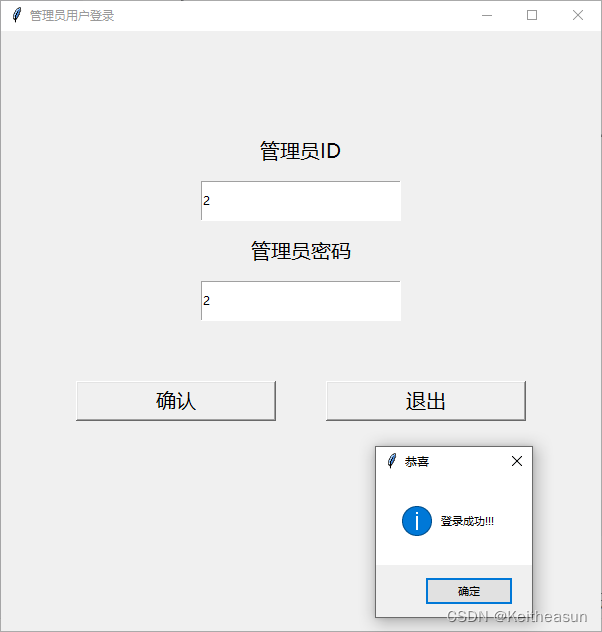

书籍管理

书籍分类 
书籍删除

若ID存在才删除,否则系统提示错误
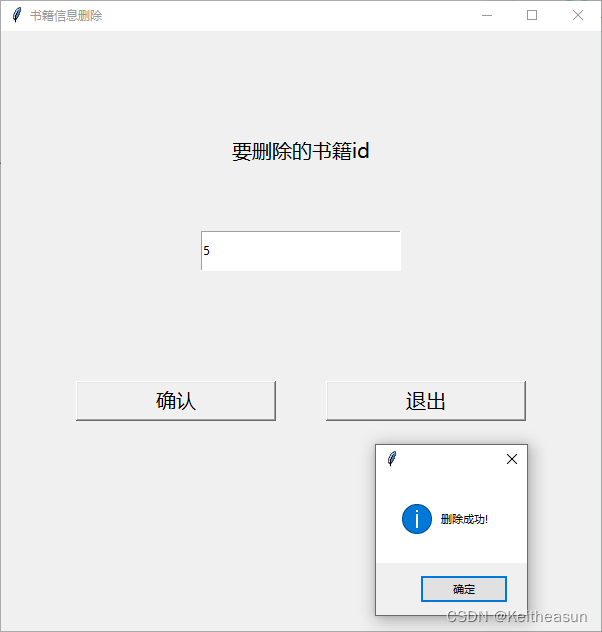
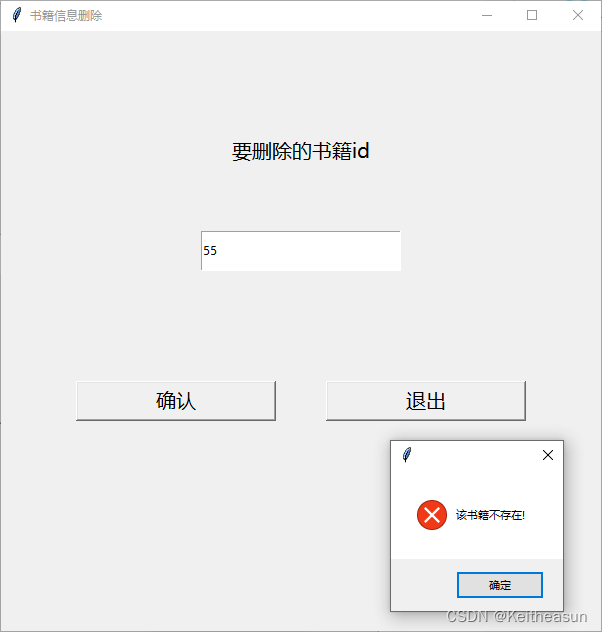

书籍录入
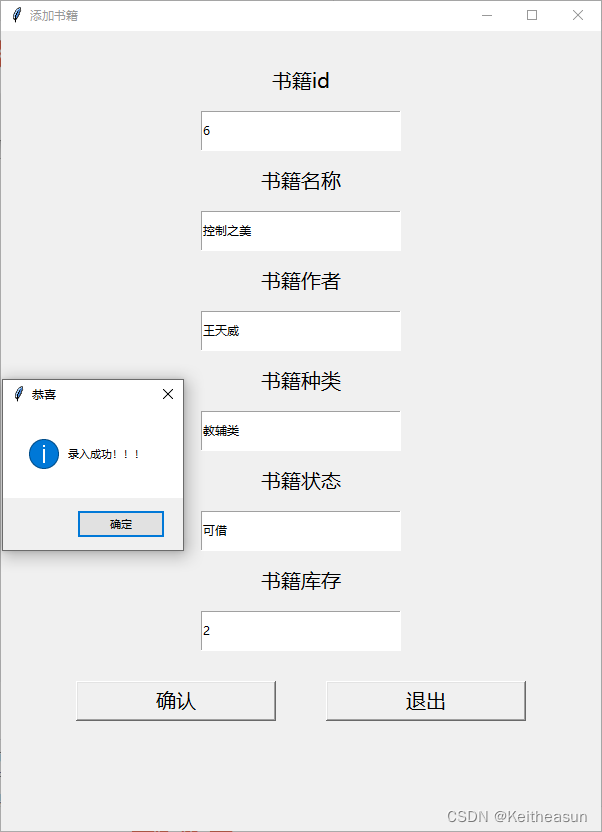
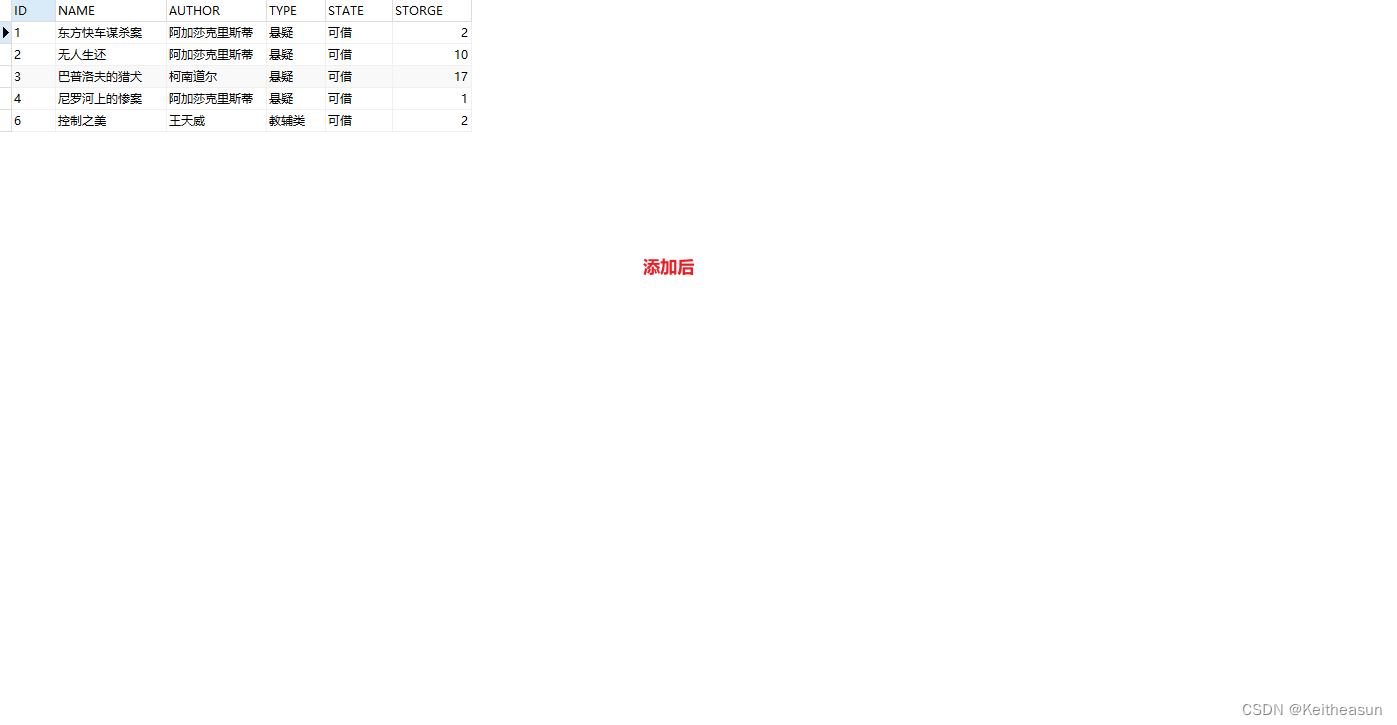
若是重复的书籍,则会更新库存

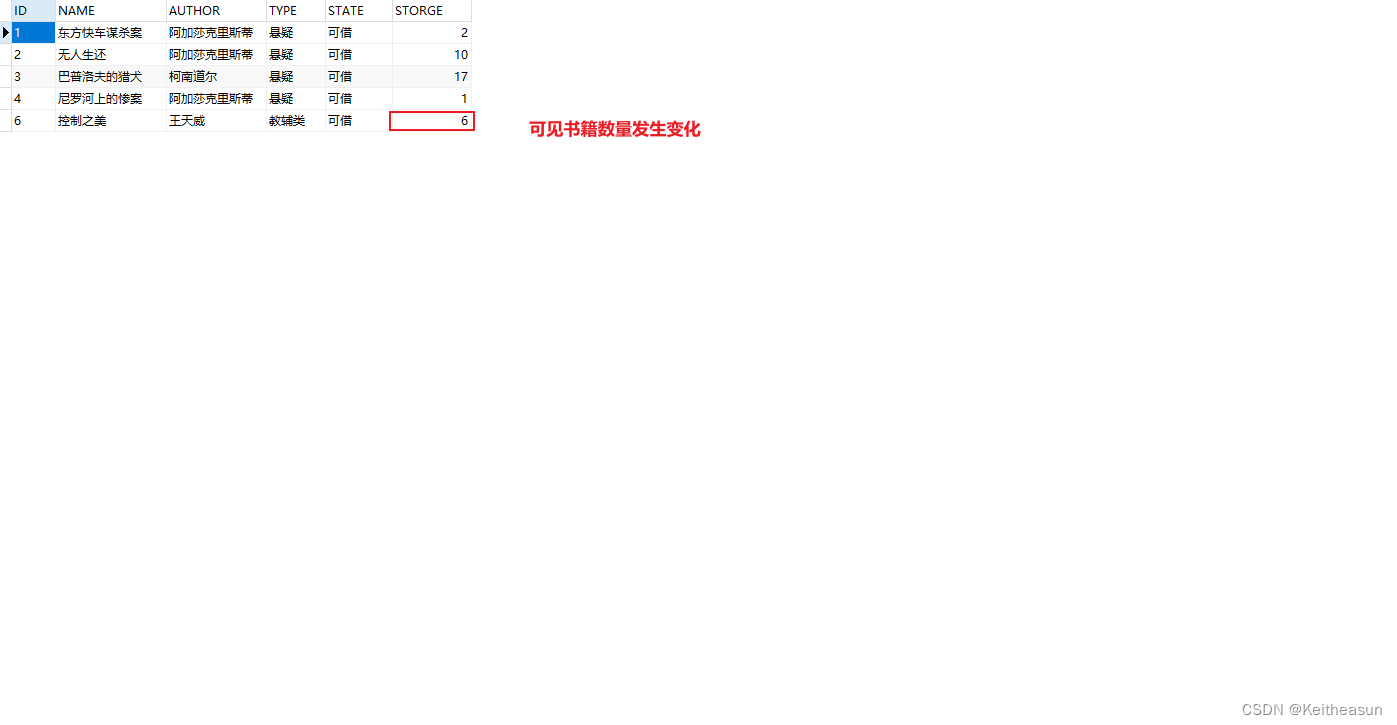
用户创建
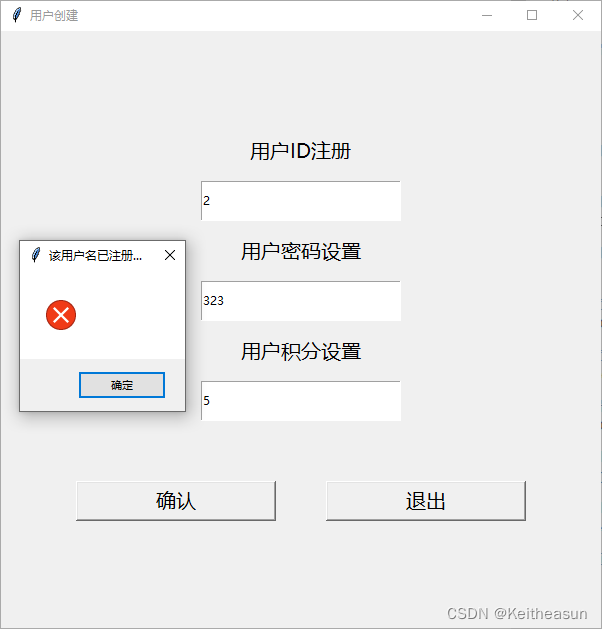
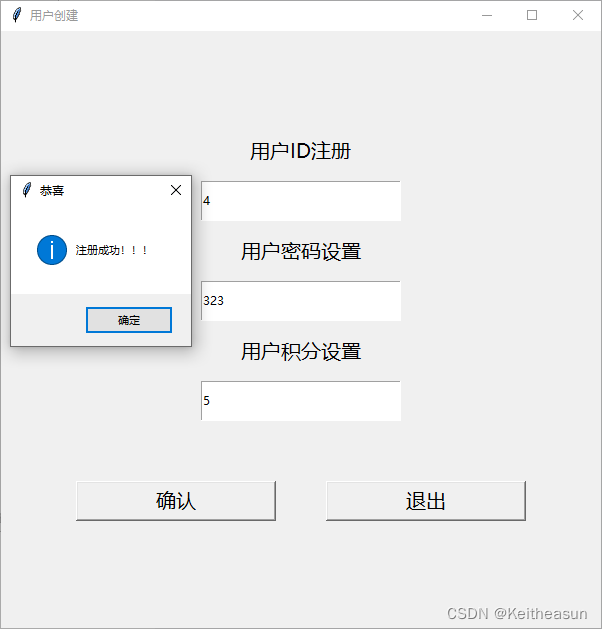
创建后

用户信息修改
和之前的差不多,这里不多介绍

超级管理员功能

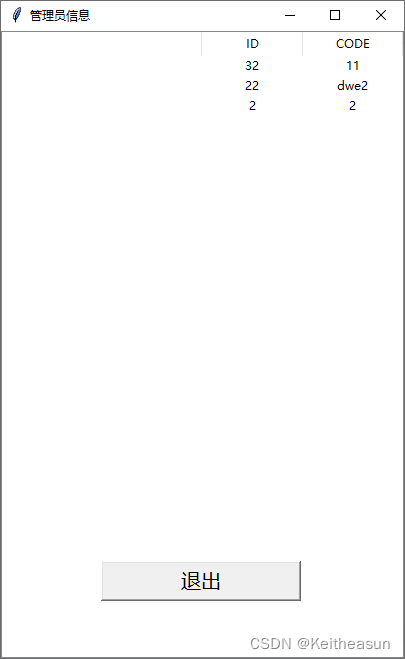
用户功能
用户登录

借书功能

提示积分不足,那么让我们先送一本书
赠与书籍

此时我们再查看一次积分信息

这样应该就可以借书了,那就把刚刚那本书借回来(doge
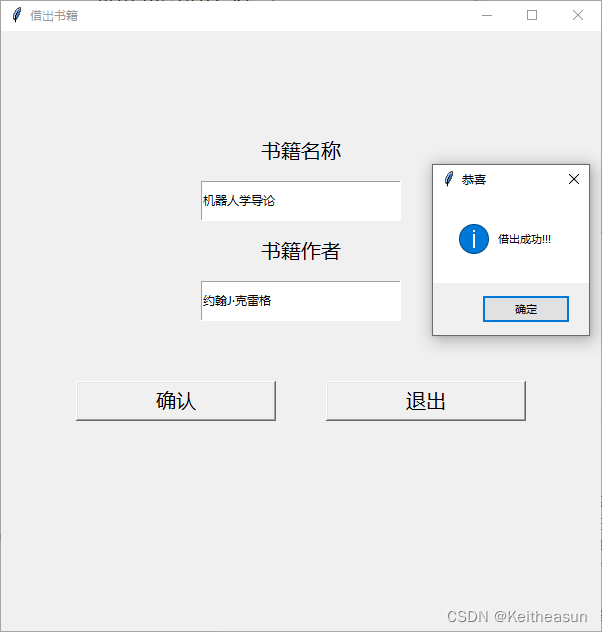
此时显示书籍被我们借走了,且书籍状态自动变更
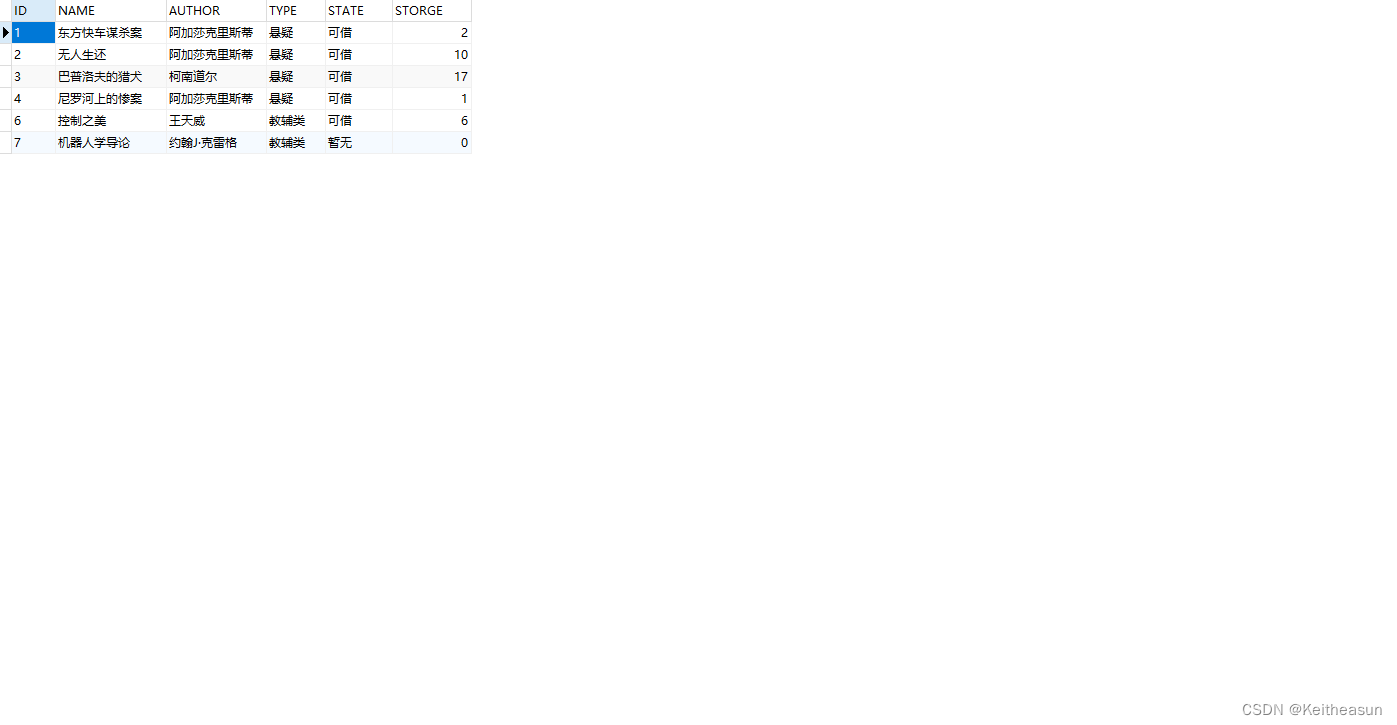
若此时还有人来借书的话,系统会提示

至此,所有功能大致介绍完毕
完整源码
#!/usr/bin/python3
from tkinter import *
from tkinter import messagebox
import pymysql
from tkinter import ttk
# 打开数据库连接
def Sql_link():
#生成数据库
db = pymysql.connect(host='localhost',user='root',password='321',database='library')
# 使用 cursor() 方法创建一个游标对象
cursor = db.cursor()
return db,cursor
class Manager:
# 用户注册
def create_client(self):
# 创建窗口
create_client_root = Tk()
create_client_root.title("用户创建")
create_client_root.config(width=600)
create_client_root.config(height=600)
# 定义关联变量
client_id = StringVar(create_client_root, value='')
client_code = StringVar(create_client_root, value='')
client_rate = StringVar(create_client_root, value='')
# 提示性标签
labelclient_id = Label(create_client_root, text="用户ID注册", font=("微软雅黑 -20"))
labelclient_code = Label(create_client_root, text="用户密码设置", font=("微软雅黑 -20"))
labelclient_rate = Label(create_client_root, text="用户积分设置", font=("微软雅黑 -20"))
# 设定标签位置
labelclient_id.place(x=200, y=100, height=40, width=200)
labelclient_code.place(x=200, y=200, height=40, width=200)
labelclient_rate.place(x=200, y=300, height=40, width=200)
# 定义录入信息文本框,以关联变量形式存储
entryclient_id = Entry((create_client_root), textvariable=client_id)
entryclient_id.place(x=200, y=150, height=40, width=200)
entryclient_code = Entry((create_client_root), textvariable=client_code)
entryclient_code.place(x=200, y=250, height=40, width=200)
entryclient_rate = Entry((create_client_root), textvariable=client_rate)
entryclient_rate.place(x=200, y=350, height=40, width=200)
# 录入信息回调函数
def Button_Ok():
# 设置标志位判断是否存在ID重复
flag = 0
# 连接数据库
db, cur = Sql_link()
# 将得到的StringVar对象传值回来
data_client_id = str(entryclient_id.get())
data_client_code = str(entryclient_code.get())
data_client_rate = str(entryclient_rate.get())
# 判断是否ID重复
search = cur.execute("SELECT * FROM client WHERE id = " + data_client_id + ';')
if (search > 0):
flag = 1
else:
flag = 0
if (flag == 0):
try:
# 写入数据
sql1 = "INSERT INTO client(id,code,rate)"
sql1 += "VALUES('%s','%s','%s')" % (data_client_id, data_client_code,data_client_rate)
cur.execute(sql1)
db.commit()
messagebox.showinfo(title="恭喜", message="注册成功!!!")
create_client_root.destroy()
except:
messagebox.showerror(message="注册失败!!!")
else:
messagebox.showerror("该用户名已注册!!!")
# 确认以及退出按钮
Ok_Button = Button(create_client_root, text="确认", font=("微软雅黑 -20"), command=Button_Ok)
Exit_Button = Button(create_client_root, text="退出", font=("微软雅黑 -20"), command=create_client_root.destroy)
Ok_Button.place(x=75, y=450, height=40, width=200)
Exit_Button.place(x=325, y=450, height=40, width=200)
# 添加书籍
def insert_book(self):
# 创建窗口
insert_book_root = Tk()
insert_book_root.title("添加书籍")
insert_book_root.config(width=600)
insert_book_root.config(height=800)
# 定义关联变量
book_id = StringVar(insert_book_root, value='')
book_name = StringVar(insert_book_root, value='')
book_author = StringVar(insert_book_root, value='')
book_type = StringVar(insert_book_root, value='')
book_state = StringVar(insert_book_root, value='')
book_storge = StringVar(insert_book_root, value='')
# 提示性标签
labelbook_id = Label(insert_book_root, text="书籍id", font=("微软雅黑 -20"))
labelbook_name = Label(insert_book_root, text="书籍名称", font=("微软雅黑 -20"))
labelbook_author = Label(insert_book_root, text="书籍作者", font=("微软雅黑 -20"))
labelbook_type = Label(insert_book_root, text="书籍种类", font=("微软雅黑 -20"))
labelbook_state = Label(insert_book_root, text="书籍状态", font=("微软雅黑 -20"))
labelbook_storge = Label(insert_book_root, text="书籍库存", font=("微软雅黑 -20"))
# 设定标签位置
labelbook_id.place(x=200, y=30, height=40, width=200)
labelbook_name.place(x=200, y=130, height=40, width=200)
labelbook_author.place(x=200, y=230, height=40, width=200)
labelbook_type.place(x=200, y=330, height=40, width=200)
labelbook_state.place(x=200, y=430, height=40, width=200)
labelbook_storge.place(x=200, y=530, height=40, width=200)
# 定义录入信息文本框,以关联变量形式存储
entrybook_id = Entry((insert_book_root), textvariable=book_id)
entrybook_id.place(x=200, y=80, height=40, width=200)
entrybook_name = Entry((insert_book_root), textvariable=book_name)
entrybook_name.place(x=200, y=180, height=40, width=200)
entrybook_author = Entry((insert_book_root), textvariable=book_author)
entrybook_author.place(x=200, y=280, height=40, width=200)
entrybook_type = Entry((insert_book_root), textvariable=book_type)
entrybook_type.place(x=200, y=380, height=40, width=200)
entrybook_state = Entry((insert_book_root), textvariable=book_state)
entrybook_state.place(x=200, y=480, height=40, width=200)
entrybook_storge = Entry((insert_book_root), textvariable=book_storge)
entrybook_storge.place(x=200, y=580, height=40, width=200)
# 录入信息回调函数
def Button_Ok():
# 设置标志位判断是否存在ID重复
flag = 0
# 连接数据库
db, cur = Sql_link()
# 将得到的StringVar对象传值回来
data_book_id = str(entrybook_id.get())
data_book_name = str(entrybook_name.get())
data_book_author = str(entrybook_author.get())
data_book_type = str(entrybook_type.get())
data_book_state = str(entrybook_state.get())
data_book_storge = str(entrybook_storge.get())
# 判断是否信息重复
search1 = cur.execute("SELECT * FROM book WHERE name = '%s'" % data_book_name)
search2 = cur.execute("SELECT * FROM book WHERE author = '%s'" % data_book_author)
if (search1 > 0 and search2 > 0):
flag = 1
else:
flag = 0
if (flag == 0):
try:
# 写入数据
sql1 = "INSERT INTO book(id,name,author,type,state,storge)"
sql1 += "VALUES('%s','%s','%s','%s','%s','%s')" % (
data_book_id, data_book_name, data_book_author, data_book_type, data_book_state, data_book_storge)
cur.execute(sql1)
db.commit()
messagebox.showinfo(title="恭喜", message="录入成功!!!")
insert_book_root.destroy()
except:
messagebox.showerror(message="注册失败!!!")
else:
# 查找对应的ID号
sql2 = "UPDATE book SET storge = storge + %d WHERE name = '%s'" % (
eval(data_book_storge), data_book_name)
cur.execute(sql2)
db.commit()
messagebox.showinfo(title="恭喜", message="录入成功!!!")
# 确认以及退出按钮
Ok_Button = Button(insert_book_root, text="确认", font=("微软雅黑 -20"), command=Button_Ok)
Exit_Button = Button(insert_book_root, text="退出", font=("微软雅黑 -20"), command=insert_book_root.destroy)
Ok_Button.place(x=75, y=650, height=40, width=200)
Exit_Button.place(x=325, y=650, height=40, width=200)
# 按作者筛选书籍
def sort_by_author(self):
sort_by_author_root = Tk()
sort_by_author_root.title("按作者分类")
sort_by_author_root.config(width=600)
sort_by_author_root.config(height=600)
# 创建树对象用于展示数据
book_tree = ttk.Treeview(sort_by_author_root, height=30, columns=['1', '2', '3', '4', '5', '6'],
show='tree headings')
book_tree.column('1', width=100, anchor='center')
book_tree.column('2', width=100, anchor='center')
book_tree.column('3', width=100, anchor='center')
book_tree.column('4', width=100, anchor='center')
book_tree.column('5', width=100, anchor='center')
book_tree.column('6', width=100, anchor='center')
# 设置树的表头
book_tree.heading('1', text='ID')
book_tree.heading('2', text='NAME')
book_tree.heading('3', text='作者')
book_tree.heading('4', text='类型')
book_tree.heading('5', text='状态')
book_tree.heading('6', text='库存')
try:
db, cur = Sql_link()
sql = "SELECT * FROM book ORDER BY author DESC"
cur.execute(sql)
db.commit()
# 给树各项参数赋值,若为NONE值则break
for i in range(0, 30):
results = cur.fetchone()
while (results):
book_tree.insert('', i, values=results)
break
except:
messagebox.showerror(message="排序失败!")
book_tree.pack()
Exit_Button = Button(sort_by_author_root, text="退出", font=("微软雅黑 -20"), command=sort_by_author_root.destroy)
Exit_Button.place(x=350, y=530, height=40, width=200)
# 按题材筛选书籍
def sort_by_type(self):
sort_by_type_root = Tk()
sort_by_type_root.title("按种类分类")
sort_by_type_root.config(width=600)
sort_by_type_root.config(height=600)
# 创建树对象用于展示数据
book_tree = ttk.Treeview(sort_by_type_root, height=30, columns=['1', '2', '3', '4', '5', '6'],
show='tree headings')
book_tree.column('1', width=100, anchor='center')
book_tree.column('2', width=100, anchor='center')
book_tree.column('3', width=100, anchor='center')
book_tree.column('4', width=100, anchor='center')
book_tree.column('5', width=100, anchor='center')
book_tree.column('6', width=100, anchor='center')
# 设置树的表头
book_tree.heading('1', text='ID')
book_tree.heading('2', text='NAME')
book_tree.heading('3', text='作者')
book_tree.heading('4', text='类型')
book_tree.heading('5', text='状态')
book_tree.heading('6', text='库存')
try:
db, cur = Sql_link()
sql = "SELECT * FROM book ORDER BY type DESC"
cur.execute(sql)
db.commit()
# 给树各项参数赋值,若为NONE值则break
for i in range(0, 30):
results = cur.fetchone()
while (results):
book_tree.insert('', i, values=results)
break
except:
messagebox.showerror(message="排序失败!")
book_tree.pack()
Exit_Button = Button(sort_by_type_root, text="退出", font=("微软雅黑 -20"), command=sort_by_type_root.destroy)
Exit_Button.place(x=350, y=530, height=40, width=200)
# 书籍管理
def book_menu(self):
# 创建窗口
book_menu_root = Tk()
book_menu_root.title("功能菜单")
book_menu_root.config(width=600)
book_menu_root.config(height=600)
# 删除书籍
def delete_book():
# 创建窗口
delete_book_root = Tk()
delete_book_root.title("书籍信息删除")
delete_book_root.config(width=600)
delete_book_root.config(height=600)
book_name = StringVar(delete_book_root, value='')
# 提示性标签
labelbook_name = Label(delete_book_root, text="要删除的书籍id", font=("微软雅黑 -20"))
entrybook_name = Entry(delete_book_root, textvariable=book_name)
labelbook_name.place(x=200, y=100, height=40, width=200)
entrybook_name.place(x=200, y=200, height=40, width=200)
def Button_Ok():
db, cur = Sql_link()
book_name = eval(entrybook_name.get())
# 查找对应的书籍
sql = "SELECT * FROM book WHERE id = %s" % (book_name)
search = cur.execute(sql)
if (search > 0):
messagebox.showinfo(message="删除成功!")
# 删除目标行
sql1 = "DELETE FROM book WHERE id = %s" % (book_name)
cur.execute(sql1)
db.commit()
else:
messagebox.showerror(message="该书籍不存在!")
Ok_Button = Button(delete_book_root, text="确认", font=("微软雅黑 -20"), command=Button_Ok)
Exit_Button = Button(delete_book_root, text="退出", font=("微软雅黑 -20"), command=delete_book_root.destroy)
Ok_Button.place(x=75, y=350, height=40, width=200)
Exit_Button.place(x=325, y=350, height=40, width=200)
# 设置按钮
button_book1 = Button(book_menu_root, text="按作者分类", font=("微软雅黑 -20"), command=self.sort_by_author)
button_book2 = Button(book_menu_root, text="按题材分类", font=("微软雅黑 -20"), command=self.sort_by_type)
button_book3 = Button(book_menu_root, text="书籍删除", font=("微软雅黑 -20"), command=delete_book)
button_book4 = Button(book_menu_root, text="书籍录入", font=("微软雅黑 -20"), command=self.insert_book)
button_book1.place(x=200, y=30, height=40, width=200)
button_book2.place(x=200, y=130, height=40, width=200)
button_book3.place(x=200, y=230, height=40, width=200)
button_book4.place(x=200, y=330, height=40, width=200)
Exit_Button = Button(book_menu_root, text="退出", font=("微软雅黑 -20"), command=book_menu_root.destroy)
Exit_Button.place(x=200, y=430, height=40, width=200)
# 用户信息修改
def edit_client(self):
# 创建窗口
show_edit_client_root = Tk()
show_edit_client_root.title("功能菜单")
show_edit_client_root.config(width=600)
show_edit_client_root.config(height=600)
def client_info():
client_info_root = Tk()
client_info_root.title("用户信息")
client_info_root.config(width=600)
client_info_root.config(height=600)
# 创建树对象用于展示数据
client_info_tree = ttk.Treeview(client_info_root, height=30, columns=['1', '2', '3'],
show='tree headings')
client_info_tree.column('1', width=100, anchor='center')
client_info_tree.column('2', width=100, anchor='center')
client_info_tree.column('3', width=100, anchor='center')
# 设置树的表头
client_info_tree.heading('1', text='ID')
client_info_tree.heading('2', text='CODE')
client_info_tree.heading('3', text='RATE')
try:
db, cur = Sql_link()
sql = "SELECT * FROM client ORDER BY rate DESC"
cur.execute(sql)
db.commit()
# 给树各项参数赋值,若为NONE值则break
for i in range(0, 30):
results = cur.fetchone()
while (results):
client_info_tree.insert('', i, values=results)
break
except:
messagebox.showerror(message="排序失败!")
client_info_tree.pack()
Exit_Button = Button(client_info_root, text="退出", font=("微软雅黑 -20"), command=client_info_root.destroy)
Exit_Button.place(x=100, y=530, height=40, width=200)
def delete_client():
delete_client_root = Tk()
delete_client_root.title("用户删除")
delete_client_root.config(width=600)
delete_client_root.config(height=600)
# 定义关联变量
client_id = StringVar(delete_client_root, value='')
# 提示性标签
labelclient_id = Label(delete_client_root, text="用户ID", font=("微软雅黑 -20"))
# 设定标签位置
labelclient_id.place(x=200, y=150, height=40, width=200)
# 定义录入信息文本框,以关联变量形式存储
entryclient_id = Entry(delete_client_root, textvariable=client_id)
entryclient_id.place(x=200, y=200, height=40, width=200)
def Button_Ok():
db, cur = Sql_link()
client_id = eval(entryclient_id.get())
sql = "DELETE FROM client WHERE ID = %d" % (client_id)
try:
cur.execute(sql)
db.commit()
messagebox.showinfo(message="删除成功!")
except:
messagebox.showerror(message="删除失败!")
Ok_Button = Button(delete_client_root, text="确认", font=("微软雅黑 -20"), command=Button_Ok)
Exit_Button = Button(delete_client_root, text="退出", font=("微软雅黑 -20"), command=delete_client_root.destroy)
Ok_Button.place(x=75, y=300, height=40, width=200)
Exit_Button.place(x=325, y=300, height=40, width=200)
def change_code():
# 创建窗口
change_code_root = Tk()
change_code_root.title("用户密码修改")
change_code_root.config(width=600)
change_code_root.config(height=600)
client_name = StringVar(change_code_root, value='')
old_client_code = StringVar(change_code_root, value='')
# 提示性标签
labelclient_name = Label(change_code_root, text="要修改的用户ID", font=("微软雅黑 -20"))
entryclient_name = Entry(change_code_root, textvariable=client_name)
labelold_client_code = Label(change_code_root, text="请输入原密码", font=("微软雅黑 -20"))
entryold_client_code = Entry(change_code_root, textvariable=old_client_code)
labelclient_name.place(x=200, y=50, height=40, width=200)
entryclient_name.place(x=200, y=150, height=40, width=200)
labelold_client_code.place(x=200, y=250, height=40, width=200)
entryold_client_code.place(x=200, y=350, height=40, width=200)
def Button_Ok():
db, cur = Sql_link()
client_name = str(entryclient_name.get())
old_client_code = entryold_client_code.get()
# 匹配对应的ID
sql = "SELECT * FROM client WHERE id=%s AND code='%s'" % (client_name, old_client_code)
search = cur.execute(sql)
if (search > 0):
def Button_Ok():
try:
new_client_code = entrynew_client_code.get()
messagebox.showinfo(message="修改成功!")
# 利用UPDATE来修改密码
sql1 = "UPDATE client SET code = '%s' WHERE id = '%s'" % (new_client_code, client_name)
cur.execute(sql1)
db.commit()
except:
messagebox.showerror(message="修改失败!")
# 创建新窗口
input_code_root = Tk()
input_code_root.title("用户密码修改")
input_code_root.config(width=600)
input_code_root.config(height=600)
# 设置关联变量
new_client_code = StringVar(input_code_root, value='')
labelnew_client_code = Label(input_code_root, text="新的密码", font=("微软雅黑 -20"))
entrynew_client_code = Entry(input_code_root, textvariable=new_client_code)
# 设置提示性标签
labelnew_client_code.place(x=200, y=200, height=40, width=200)
entrynew_client_code.place(x=200, y=300, height=40, width=200)
Ok_Button = Button(input_code_root, text="确认", font=("微软雅黑 -20"), command=Button_Ok)
Exit_Button = Button(input_code_root, text="退出", font=("微软雅黑 -20"), command=input_code_root.destroy)
Ok_Button.place(x=75, y=450, height=40, width=200)
Exit_Button.place(x=325, y=450, height=40, width=200)
else:
messagebox.showerror(message="该用户不存在或密码错误!")
Ok_Button = Button(change_code_root, text="确认", font=("微软雅黑 -20"), command=Button_Ok)
Exit_Button = Button(change_code_root, text="退出", font=("微软雅黑 -20"), command=change_code_root.destroy)
Ok_Button.place(x=75, y=450, height=40, width=200)
Exit_Button.place(x=325, y=450, height=40, width=200)
# 设置按钮
button_client1 = Button(show_edit_client_root, text="用户信息", font=("微软雅黑 -20"), command=client_info)
button_client2 = Button(show_edit_client_root, text="账户删除", font=("微软雅黑 -20"), command=delete_client)
button_client3 = Button(show_edit_client_root, text="密码修改", font=("微软雅黑 -20"), command=change_code)
button_client1.place(x=200, y=130, height=40, width=200)
button_client2.place(x=200, y=230, height=40, width=200)
button_client3.place(x=200, y=330, height=40, width=200)
Exit_Button = Button(show_edit_client_root, text="退出", font=("微软雅黑 -20"), command=show_edit_client_root.destroy)
Exit_Button.place(x=200, y=430, height=40, width=200)
# 用户积分修改
def rate_menu(self):
rate_menu_root = Tk()
rate_menu_root.title("用户积分修改")
rate_menu_root.config(width=600)
rate_menu_root.config(height=600)
# 定义关联变量
client_id = StringVar(rate_menu_root, value='')
client_rate = StringVar(rate_menu_root, value='')
# 提示性标签
labelclient_id = Label(rate_menu_root, text="用户ID", font=("微软雅黑 -20"))
labelclient_rate = Label(rate_menu_root, text="积分数", font=("微软雅黑 -20"))
# 设定标签位置
labelclient_id.place(x=200, y=50, height=40, width=200)
labelclient_rate.place(x=200, y=150, height=40, width=200)
# 定义录入信息文本框,以关联变量形式存储
entryclient_id = Entry(rate_menu_root, textvariable=client_id)
entryclient_id.place(x=200, y=100, height=40, width=200)
entryclient_rate = Entry(rate_menu_root, textvariable=client_rate)
entryclient_rate.place(x=200, y=200, height=40, width=200)
# 确认以及退出按钮
def Button_Ok():
# 注意数据类型转换
db, cur = Sql_link()
client_id = str(entryclient_id.get())
client_rate = eval(entryclient_rate.get())
try:
sql = "UPDATE client SET rate = %d WHERE id = '%s'" % (client_rate,client_id)
cur.execute(sql)
db.commit()
messagebox.showinfo(message="积分修改!")
except:
messagebox.showerror(message="积分修改失败")
Ok_Button = Button(rate_menu_root, text="确认", font=("微软雅黑 -20"), command=Button_Ok)
Exit_Button = Button(rate_menu_root, text="退出", font=("微软雅黑 -20"), command=rate_menu_root.destroy)
Ok_Button.place(x=75, y=400, height=40, width=200)
Exit_Button.place(x=325, y=400, height=40, width=200)
# 功能菜单
def manager_menu(self):
# 创建窗口
show_manager_root = Tk()
show_manager_root.title("功能菜单")
show_manager_root.config(width=600)
show_manager_root.config(height=600)
# 设置按钮
button_manager1 = Button(show_manager_root, text="书籍管理", font=("微软雅黑 -20"), command=self.book_menu)
button_manager2 = Button(show_manager_root, text="创建用户", font=("微软雅黑 -20"), command=self.create_client)
button_manager3 = Button(show_manager_root, text="修改用户信息", font=("微软雅黑 -20"), command=self.edit_client)
button_manager4 = Button(show_manager_root, text="积分信息", font=("微软雅黑 -20"), command=self.rate_menu)
button_manager1.place(x=200, y=30, height=40, width=200)
button_manager2.place(x=200, y=130, height=40, width=200)
button_manager3.place(x=200, y=230, height=40, width=200)
button_manager4.place(x=200, y=330, height=40, width=200)
Exit_Button = Button(show_manager_root, text="退出", font=("微软雅黑 -20"), command=show_manager_root.destroy)
Exit_Button.place(x=200, y=430, height=40, width=200)
# 管理员登录
def load_manager(self):
# 创建窗口
load_manager_root = Tk()
load_manager_root.title("管理员用户登录")
load_manager_root.config(width=600)
load_manager_root.config(height=600)
# 定义关联变量
manager_name = StringVar(load_manager_root, value='')
manager_code = StringVar(load_manager_root, value='')
# 提示性标签
labelmanager_name = Label(load_manager_root, text="管理员ID", font=("微软雅黑 -20"))
labelmanager_code = Label(load_manager_root, text="管理员密码", font=("微软雅黑 -20"))
# 设定标签位置
labelmanager_name.place(x=200, y=100, height=40, width=200)
labelmanager_code.place(x=200, y=200, height=40, width=200)
# 定义录入信息文本框,以关联变量形式存储
entrymanager_name = Entry((load_manager_root), textvariable=manager_name)
entrymanager_name.place(x=200, y=150, height=40, width=200)
entrymanager_code = Entry((load_manager_root), textvariable=manager_code)
entrymanager_code.place(x=200, y=250, height=40, width=200)
def Button_Ok():
# 连接数据库
db, cur = Sql_link()
# 将得到的StringVar对象传值回来
data_manager_name = str(entrymanager_name.get())
data_manager_code = str(entrymanager_code.get())
# 判断ID与密码是否能够匹配上
sql = "SELECT * FROM manager WHERE id=%s AND code='%s'" % (data_manager_name, data_manager_code)
search = cur.execute(sql)
if (search > 0):
messagebox.showinfo(title="恭喜", message="登录成功!!!")
load_manager_root.destroy()
self.manager_menu()
else:
messagebox.showerror(message="该账号不存在!")
Ok_Button = Button(load_manager_root, text="确认", font=("微软雅黑 -20"), command=Button_Ok)
Exit_Button = Button(load_manager_root, text="退出", font=("微软雅黑 -20"), command=load_manager_root.destroy)
Ok_Button.place(x=75, y=350, height=40, width=200)
Exit_Button.place(x=325, y=350, height=40, width=200)
class Root_Manager(Manager):
# 创建管理员
def create_manager(self):
# 创建窗口
create_manager_root = Tk()
create_manager_root.title("管理员用户创建")
create_manager_root.config(width=600)
create_manager_root.config(height=600)
# 定义关联变量
manager_name = StringVar(create_manager_root, value='')
manager_code = StringVar(create_manager_root, value='')
# 提示性标签
labelmanager_name = Label(create_manager_root, text="管理员ID注册", font=("微软雅黑 -20"))
labelmanager_code = Label(create_manager_root, text="管理员密码设置", font=("微软雅黑 -20"))
# 设定标签位置
labelmanager_name.place(x=200, y=100, height=40, width=200)
labelmanager_code.place(x=200, y=200, height=40, width=200)
# 定义录入信息文本框,以关联变量形式存储
entrymanager_name = Entry((create_manager_root), textvariable=manager_name)
entrymanager_name.place(x=200, y=150, height=40, width=200)
entrymanager_code = Entry((create_manager_root), textvariable=manager_code)
entrymanager_code.place(x=200, y=250, height=40, width=200)
# 录入信息回调函数
def Button_Ok():
# 设置标志位判断是否存在ID重复
flag = 0
# 连接数据库
db, cur = Sql_link()
# 将得到的StringVar对象传值回来
data_manager_name = str(entrymanager_name.get())
data_manager_code = str(entrymanager_code.get())
# 判断是否ID重复
search = cur.execute("SELECT * FROM manager WHERE id = '%s'" %(data_manager_name))
if (search > 0):
flag = 1
else:
flag = 0
if (flag == 0):
try:
# 写入数据
sql1 = "INSERT INTO manager(id,code)"
sql1 += "VALUES('%s','%s')" % (data_manager_name, data_manager_code)
cur.execute(sql1)
db.commit()
messagebox.showinfo(title="恭喜", message="注册成功!!!")
create_manager_root.destroy()
except:
messagebox.showerror(message="注册失败!!!")
else:
messagebox.showerror("该用户名已注册!!!",message="注册失败!!!")
# 确认以及退出按钮
Ok_Button = Button(create_manager_root, text="确认", font=("微软雅黑 -20"), command=Button_Ok)
Exit_Button = Button(create_manager_root, text="退出", font=("微软雅黑 -20"), command=create_manager_root.destroy)
Ok_Button.place(x=75, y=350, height=40, width=200)
Exit_Button.place(x=325, y=350, height=40, width=200)
# 展示管理员信息
def show_manager_info(self):
show_manager_info_root = Tk()
show_manager_info_root.title("管理员信息")
show_manager_info_root.config(width=600)
show_manager_info_root.config(height=600)
# 创建树对象用于展示数据
show_manager_info_tree = ttk.Treeview(show_manager_info_root, height=30, columns=['1', '2'],
show='tree headings')
show_manager_info_tree.column('1', width=100, anchor='center')
show_manager_info_tree.column('2', width=100, anchor='center')
# 设置树的表头
show_manager_info_tree.heading('1', text='ID')
show_manager_info_tree.heading('2', text='CODE')
try:
db, cur = Sql_link()
sql = "SELECT * FROM manager ORDER BY id DESC"
cur.execute(sql)
db.commit()
# 给树各项参数赋值,若为NONE值则break
for i in range(0, 30):
results = cur.fetchone()
while (results):
show_manager_info_tree.insert('', i, values=results)
break
except:
messagebox.showerror(message="排序失败!")
show_manager_info_tree.pack()
Exit_Button = Button(show_manager_info_root, text="退出", font=("微软雅黑 -20"), command=show_manager_info_root.destroy)
Exit_Button.place(x=100, y=530, height=40, width=200)
# 删除管理员
def delete_manager(self):
# 创建窗口
delete_manager_root = Tk()
delete_manager_root.title("管理员信息删除")
delete_manager_root.config(width=600)
delete_manager_root.config(height=600)
manager_name = StringVar(delete_manager_root, value='')
# 提示性标签
labelmanager_name = Label(delete_manager_root, text="要删除的管理员ID", font=("微软雅黑 -20"))
entrymanager_name = Entry(delete_manager_root, textvariable=manager_name)
labelmanager_name.place(x=200, y=100, height=40, width=200)
entrymanager_name.place(x=200, y=200, height=40, width=200)
def Button_Ok():
db, cur = Sql_link()
manager_name = eval(entrymanager_name.get())
# 查找对应的ID号
sql = "SELECT * FROM manager WHERE id = %s" % (manager_name)
search = cur.execute(sql)
if (search > 0):
messagebox.showinfo(message="删除成功!")
# 删除目标行
sql1 = "DELETE FROM manager WHERE id = %s" % (manager_name)
cur.execute(sql1)
db.commit()
else:
messagebox.showerror(message="该用户不存在!")
Ok_Button = Button(delete_manager_root, text="确认", font=("微软雅黑 -20"), command=Button_Ok)
Exit_Button = Button(delete_manager_root, text="退出", font=("微软雅黑 -20"), command=delete_manager_root.destroy)
Ok_Button.place(x=75, y=350, height=40, width=200)
Exit_Button.place(x=325, y=350, height=40, width=200)
# 超级管理员菜单
def root_manager_menu(self):
# 创建窗口
show_root_manager_root = Tk()
show_root_manager_root.title("功能菜单")
show_root_manager_root.config(width=600)
show_root_manager_root.config(height=600)
# 设置按钮
button_root_manager1 = Button(show_root_manager_root, text="创建管理员", font=("微软雅黑 -20"),
command=self.create_manager)
button_root_manager2 = Button(show_root_manager_root, text="管理员信息", font=("微软雅黑 -20"),
command=self.show_manager_info)
button_root_manager3 = Button(show_root_manager_root, text="管理员权限", font=("微软雅黑 -20"),
command=self.manager_menu)
button_root_manager4 = Button(show_root_manager_root, text="管理员删除", font=("微软雅黑 -20"),
command=self.delete_manager)
button_root_manager1.place(x=200, y=100, height=40, width=200)
button_root_manager2.place(x=200, y=200, height=40, width=200)
button_root_manager3.place(x=200, y=300, height=40, width=200)
button_root_manager4.place(x=200, y=400, height=40, width=200)
Exit_Button = Button(show_root_manager_root, text="退出", font=("微软雅黑 -20"), command=show_root_manager_root.destroy)
Exit_Button.place(x=200, y=500, height=40, width=200)
# 超级管理员登录
def load_root_manager(self):
# 创建窗口
load_root_manager_root = Tk()
load_root_manager_root.title("超级管理员用户登录")
load_root_manager_root.config(width=600)
load_root_manager_root.config(height=600)
# 定义关联变量
root_manager_name = StringVar(load_root_manager_root, value='')
root_manager_code = StringVar(load_root_manager_root, value='')
# 提示性标签
labelroot_manager_name = Label(load_root_manager_root, text="超级管理员ID", font=("微软雅黑 -20"))
labelroot_manager_code = Label(load_root_manager_root, text="超级管理员密码", font=("微软雅黑 -20"))
# 设定标签位置
labelroot_manager_name.place(x=200, y=100, height=40, width=200)
labelroot_manager_code.place(x=200, y=200, height=40, width=200)
# 定义录入信息文本框,以关联变量形式存储
entryroot_manager_name = Entry((load_root_manager_root), textvariable=root_manager_name)
entryroot_manager_name.place(x=200, y=150, height=40, width=200)
entryroot_manager_code = Entry((load_root_manager_root), textvariable=root_manager_code)
entryroot_manager_code.place(x=200, y=250, height=40, width=200)
def Button_Ok():
# 连接数据库
db, cur = Sql_link()
# 将得到的StringVar对象传值回来
data_root_manager_name = str(entryroot_manager_name.get())
data_root_manager_code = str(entryroot_manager_code.get())
# 判断ID与密码是否能够匹配上
sql = "SELECT * FROM root_manager WHERE id=%s AND code='%s'" % (data_root_manager_name, data_root_manager_code)
search = cur.execute(sql)
if (search > 0):
messagebox.showinfo(title="恭喜", message="登录成功!!!")
load_root_manager_root.destroy()
self.root_manager_menu()
else:
messagebox.showerror(message="该账号不存在!")
Ok_Button = Button(load_root_manager_root, text="确认", font=("微软雅黑 -20"), command=Button_Ok)
Exit_Button = Button(load_root_manager_root, text="退出", font=("微软雅黑 -20"), command=load_root_manager_root.destroy)
Ok_Button.place(x=75, y=350, height=40, width=200)
Exit_Button.place(x=325, y=350, height=40, width=200)
class Client(Manager):
# 定义用户的ID和积分全局变量
data_client_name = 0
data_client_rate = 0
# 用户登录
def load_client(self):
# 创建窗口
load_client_root = Tk()
load_client_root.title("用户登录")
load_client_root.config(width=600)
load_client_root.config(height=600)
# 定义关联变量
client_name = StringVar(load_client_root, value='')
client_code = StringVar(load_client_root, value='')
# 提示性标签
labelclient_name = Label(load_client_root, text="用户ID", font=("微软雅黑 -20"))
labelclient_code = Label(load_client_root, text="用户密码", font=("微软雅黑 -20"))
# 设定标签位置
labelclient_name.place(x=200, y=100, height=40, width=200)
labelclient_code.place(x=200, y=200, height=40, width=200)
# 定义录入信息文本框,以关联变量形式存储
entryclient_name = Entry((load_client_root), textvariable=client_name)
entryclient_name.place(x=200, y=150, height=40, width=200)
entryclient_code = Entry((load_client_root), textvariable=client_code)
entryclient_code.place(x=200, y=250, height=40, width=200)
def Button_Ok():
# 连接数据库
db, cur = Sql_link()
# 将得到的StringVar对象传值回来
global data_client_name
global data_client_rate
data_client_name = str(entryclient_name.get())
data_client_code = str(entryclient_code.get())
# 判断ID与密码是否能够匹配上
sql = "SELECT * FROM client WHERE id=%s AND code='%s'" % (
data_client_name, data_client_code)
search = cur.execute(sql)
data = cur.fetchone()
data_client_rate = data[2]
if (search > 0):
messagebox.showinfo(title="恭喜", message="登录成功!!! 积分数为%d " % (data[2]))
load_client_root.destroy()
self.client_menu()
else:
messagebox.showerror(message="该账号不存在!")
Ok_Button = Button(load_client_root, text="确认", font=("微软雅黑 -20"), command=Button_Ok)
Exit_Button = Button(load_client_root, text="退出", font=("微软雅黑 -20"),
command=load_client_root.destroy)
Ok_Button.place(x=75, y=350, height=40, width=200)
Exit_Button.place(x=325, y=350, height=40, width=200)
# 用户借书
def client_borrow_book(self):
global data_client_rate
if data_client_rate > 0:
# 创建窗口
client_borrow_book_root = Tk()
client_borrow_book_root.title("借出书籍")
client_borrow_book_root.config(width=600)
client_borrow_book_root.config(height=600)
# 定义关联变量
borrow_book_name = StringVar(client_borrow_book_root, value='')
borrow_book_author = StringVar(client_borrow_book_root, value='')
# 提示性标签
labelborrow_book_name = Label(client_borrow_book_root, text="书籍名称", font=("微软雅黑 -20"))
labelborrow_book_author = Label(client_borrow_book_root, text="书籍作者", font=("微软雅黑 -20"))
# 设定标签位置
labelborrow_book_name.place(x=200, y=100, height=40, width=200)
labelborrow_book_author.place(x=200, y=200, height=40, width=200)
# 定义录入信息文本框,以关联变量形式存储
entryborrow_book_name = Entry((client_borrow_book_root), textvariable=borrow_book_name)
entryborrow_book_name.place(x=200, y=150, height=40, width=200)
entryborrow_book_author = Entry((client_borrow_book_root), textvariable=borrow_book_author)
entryborrow_book_author.place(x=200, y=250, height=40, width=200)
def Button_Ok():
# 连接数据库
db, cur = Sql_link()
# 将得到的StringVar对象传值回来
data_borrow_book_name = str(entryborrow_book_name.get())
data_borrow_book_author = str(entryborrow_book_author.get())
# 判断书籍信息是否正确
sql = "SELECT * FROM book WHERE name='%s' AND author='%s'" % (data_borrow_book_name, data_borrow_book_author)
search = cur.execute(sql)
data = cur.fetchone()
data_book_storge = data[5]
if data_book_storge>0:
if (search > 0):
# 书籍库存-1
sql2 = "UPDATE book SET storge = storge - 1 WHERE name = '%s'AND author='%s'" % (
data_borrow_book_name, data_borrow_book_author)
global data_client_name
# 用户积分-1
sql3 = "UPDATE client SET rate = rate - 1 WHERE id = '%s'" % (data_client_name)
cur.execute(sql3)
cur.execute(sql2)
db.commit()
messagebox.showinfo(title="恭喜", message="借出成功!!!")
client_borrow_book_root.destroy()
else:
messagebox.showerror(message="该书籍不存在,请检查输入是否错误!")
else:
sql4 = "UPDATE book SET state = '暂无' WHERE name = '%s'AND author='%s'" % (
data_borrow_book_name, data_borrow_book_author)
cur.execute(sql4)
db.commit()
messagebox.showinfo(title="抱歉", message="此书暂无库存!!!")
Ok_Button = Button(client_borrow_book_root, text="确认", font=("微软雅黑 -20"), command=Button_Ok)
Exit_Button = Button(client_borrow_book_root, text="退出", font=("微软雅黑 -20"), command=client_borrow_book_root.destroy)
Ok_Button.place(x=75, y=350, height=40, width=200)
Exit_Button.place(x=325, y=350, height=40, width=200)
else:
messagebox.showerror(message="积分数小于0,无法借书!")
# 用户赠书
def client_give_book(self):
Manager.insert_book(self)
global data_client_name
db2, cur2 = Sql_link()
sql2 = "UPDATE client SET rate = rate + 2 WHERE id = '%s'" % (data_client_name)
cur2.execute(sql2)
db2.commit()
# 用户菜单
def client_menu(self):
# 创建窗口
client_menu_root = Tk()
client_menu_root.title("功能菜单")
client_menu_root.config(width=600)
client_menu_root.config(height=600)
# 设置按钮
button_client1 = Button(client_menu_root, text="借出书籍(积分-1)", font=("微软雅黑 -20"),
command=self.client_borrow_book)
button_client2 = Button(client_menu_root, text="按作者选书", font=("微软雅黑 -20"),
command=self.sort_by_author)
button_client3 = Button(client_menu_root, text="按类型选书", font=("微软雅黑 -20"),
command=self.sort_by_type)
button_client4 = Button(client_menu_root, text="赠与书籍(积分+2)", font=("微软雅黑 -20"),
command=self.client_give_book)
button_client1.place(x=200, y=50, height=40, width=200)
button_client2.place(x=200, y=150, height=40, width=200)
button_client3.place(x=200, y=250, height=40, width=200)
button_client4.place(x=200, y=350, height=40, width=200)
Exit_Button = Button(client_menu_root, text="退出", font=("微软雅黑 -20"),
command=client_menu_root.destroy)
Exit_Button.place(x=200, y=450, height=40, width=200)
#生成类的实例
Manager_Object = Manager
Root_Manager_Object = Root_Manager
Client_Object = Client
#设置登录界面
root = Tk()
# 禁止最大化按钮(只显示最小化按钮和关闭按钮)
root.resizable(False,False)
root.minsize(600,600) # 最小尺寸
root.maxsize(600,600) # 最大尺寸
root.title("图书共享管理系统")
main_button1=Button(root,text="超级管理员登录",font=("微软雅黑 -20"),command=Root_Manager().load_root_manager)
main_button2=Button(root,text="管理员登录",font=("微软雅黑 -20"),command=Manager_Object().load_manager)
main_button3=Button(root,text="用户登录",font=("微软雅黑 -20"),command=Client_Object().load_client)
main_button1.place(x=200,y=100,height=40,width=200)
main_button2.place(x=200,y=200,height=40,width=200)
main_button3.place(x=200,y=300,height=40,width=200)
Exit_Button = Button(root, text="退出", font=("微软雅黑 -20"), command=root.destroy)
Exit_Button.place(x=200, y=400, height=40, width=200)
root.mainloop()




 本文介绍了一个包含多层权限的图书管理系统的设计与实现过程。系统区分了用户、管理员及超级管理员的不同权限,并采用Python的Tkinter库进行UI设计。文章详细描述了各模块功能,如用户注册、书籍录入、信息修改等,并提供了部分核心代码。
本文介绍了一个包含多层权限的图书管理系统的设计与实现过程。系统区分了用户、管理员及超级管理员的不同权限,并采用Python的Tkinter库进行UI设计。文章详细描述了各模块功能,如用户注册、书籍录入、信息修改等,并提供了部分核心代码。
















 1458
1458










